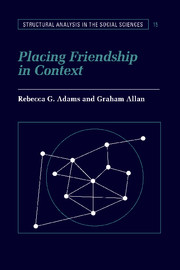Book contents
- Frontmatter
- Contents
- Notes on the contributors
- Acknowledgements
- 1 Contextualising friendship
- 2 The modernisation of friendship: individualism, intimacy, and gender in the nineteenth century
- 3 The gendered contexts of inclusive intimacy: the Hawthorne women at work and home
- 4 Friendship and the private sphere
- 5 Rich friendships, affluent friends: middle-class practices of friendship
- 6 Women's friendships in a post-modern world
- 7 Foci of activity as changing contexts for friendship
- 8 The demise of territorial determinism: online friendships
- 9 Reflections on context
- Index
- Structural Analysis in the Social Sciences
7 - Foci of activity as changing contexts for friendship
Published online by Cambridge University Press: 15 December 2009
- Frontmatter
- Contents
- Notes on the contributors
- Acknowledgements
- 1 Contextualising friendship
- 2 The modernisation of friendship: individualism, intimacy, and gender in the nineteenth century
- 3 The gendered contexts of inclusive intimacy: the Hawthorne women at work and home
- 4 Friendship and the private sphere
- 5 Rich friendships, affluent friends: middle-class practices of friendship
- 6 Women's friendships in a post-modern world
- 7 Foci of activity as changing contexts for friendship
- 8 The demise of territorial determinism: online friendships
- 9 Reflections on context
- Index
- Structural Analysis in the Social Sciences
Summary
Friendship is the most voluntary type of personal relationship. People generally understand that whether two people are neighbours, co-workers, or kin is largely determined by the surrounding institutional arrangements, but they also believe that whether they are friends is a matter for the individuals themselves to decide. People expect that many of their activities and interactions as neighbours, co-workers, and kin are determined by the circumstances: for example, neighbours interact while coming and going from their homes; co-workers interact as part of their jobs; and kin encounter one another at family functions. In contrast, people feel that they determine their own friendship activities and interactions. Nevertheless, this entire volume is devoted to showing that, even though friendship is relatively voluntary and self-determined, social context has important effects on who become friends and how those friends act towards one another.
The ‘context’ of a friendship includes everything apart from the most immediate characteristics of the relationship itself (see Allan, 1989; Blieszner and Adams, 1992; Adams and Allan in this volume). Our present task is to suggest the value of taking account of one particular aspect of the social context that is captured in the concept of a ‘focus of activity’ (Feld, 1981, 1982, 1984). A focus of activity is defined as any ‘social, psychological, legal or physical entity around which joint activities are organized’ (Feld, 1981, p. 1016). Foci of activity take varied forms, including families, work-places, voluntary organisations, and neighbourhoods, but all have the common effect of bringing a relatively limited set of individuals together in repeated interactions in and around the focused activities.
- Type
- Chapter
- Information
- Placing Friendship in Context , pp. 136 - 152Publisher: Cambridge University PressPrint publication year: 1999
- 9
- Cited by

